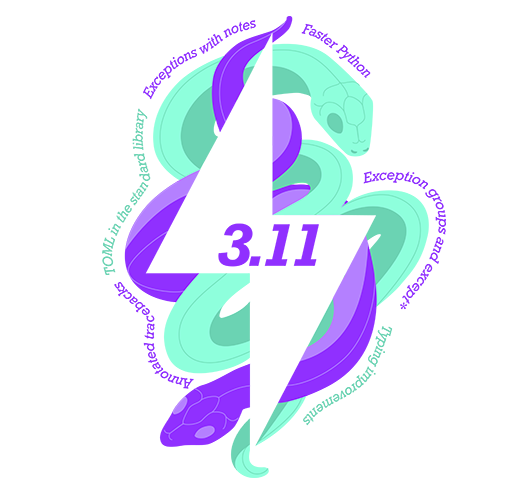Python 3.11.2
Release Date: Feb. 8, 2023

This is the second maintenance release of Python 3.11
Python 3.11.2 is the newest major release of the Python programming language, and it contains many new features and optimizations.
Major new features of the 3.11 series, compared to 3.10
Some of the new major new features and changes in Python 3.11 are:
General changes
- PEP 657 -- Include Fine-Grained Error Locations in Tracebacks
- PEP 654 -- Exception Groups and
except* - PEP 680 -- tomllib: Support for Parsing TOML in the Standard Library
- gh-90908 -- Introduce task groups to asyncio
- gh-34627 -- Atomic grouping (
(?>...)) and possessive quantifiers (*+, ++, ?+, {m,n}+) are now supported in regular expressions. - The Faster CPython Project is already yielding some exciting results. Python 3.11 is up to 10-60% faster than Python 3.10. On average, we measured a 1.22x speedup on the standard benchmark suite. See Faster CPython for details.
Typing and typing language changes
- PEP 673 -- Self Type
- PEP 646 -- Variadic Generics
- PEP 675 -- Arbitrary Literal String Type
- PEP 655 -- Marking individual TypedDict items as required or potentially-missing
- PEP 681 -- Data Class Transforms
More resources
- Online Documentation
- PEP 664, 3.11 Release Schedule
- Report bugs at https://github.com/python/cpython/issues.
- Help fund Python and its community.
And now for something completely different
Quark–gluon plasma (QGP) or quark soup is an interacting localized assembly of quarks and gluons at thermal and chemical equilibrium. The word plasma signals that free colour charges are allowed. In a 1987 summary, Léon van Hove pointed out the equivalence of the three terms: quark-gluon plasma, quark matter and a new state of matter. Since the temperature is above the Hagedorn temperature—and thus above the scale of light u,d-quark mass—the pressure exhibits the relativistic Stefan-Boltzmann format governed by temperature to the fourth power (T^4) and many practically massless quark and gluon constituents. It can be said that QGP emerges to be the new phase of strongly interacting matter which manifests its physical properties in terms of nearly free dynamics of practically massless gluons and quarks. Both quarks and gluons must be present in conditions near chemical equilibrium with their colour charge open for a new state of matter to be referred to as QGP.
In the Big Bang theory, quark–gluon plasma filled the entire Universe before matter as we know it was created. Theories predicting the existence of quark–gluon plasma were developed in the late 1970s and early 1980s. Discussions around heavy ion experimentation followed suit and the first experiment proposals were put forward at CERN and BNL in the following years. Quark–gluon plasma was detected for the first time in the laboratory at CERN in the year 2000.
Files
| Version | Operating System | Description | MD5 Sum | File Size | GPG | Sigstore | |
|---|---|---|---|---|---|---|---|
| Gzipped source tarball | Source release | f6b5226ccba5ae1ca9376aaba0b0f673 | 25.2 MB | SIG | .sigstore | ||
| XZ compressed source tarball | Source release | a957cffb58a89303b62124896881950b | 19.0 MB | SIG | .sigstore | ||
| macOS 64-bit universal2 installer | macOS | for macOS 10.9 and later | e038c3d5cee8c5210735a764d3f36f5a | 40.9 MB | SIG | CRT | SIG |
| Windows installer (64-bit) | Windows | Recommended | 4331ca54d9eacdbe6e97d6ea63526e57 | 24.2 MB | SIG | CRT | SIG |
| Windows installer (32-bit) | Windows | 2123016702bbb45688baedc3695852f4 | 23.0 MB | SIG | CRT | SIG | |
| Windows installer (ARM64) | Windows | Experimental | 040ab03501a65cc26bd340323bb1972e | 23.3 MB | SIG | CRT | SIG |
| Windows embeddable package (64-bit) | Windows | ae7de44ecbe2d3a37dbde3ce669d31b3 | 10.1 MB | SIG | CRT | SIG | |
| Windows embeddable package (32-bit) | Windows | 64853e569d7cb0d1547793000ff9c9b6 | 9.1 MB | SIG | CRT | SIG | |
| Windows embeddable package (ARM64) | Windows | 747090b80a52e8bbcb5cb65f78fee575 | 9.3 MB | SIG | CRT | SIG | |
